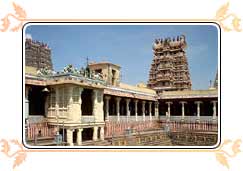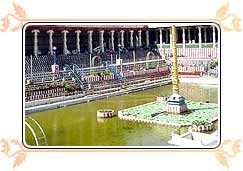| Location of Meenakshi temple: | Madurai |
| Famous For : | World Renowed Meenakashi Temples |
| Dedicated to : | Lord Shiva and Meenakashi |
| Related Links: | Madurai |
Meenakshi Temple Information : No text can do justice to the Meenakshi Madurai. The gigantic temple complex, the statues exploring the entire range of human emotions, everything here is larger than life. The Meenakshi temple complex is a city temple - one of the largest and certainly one of the most ancient. According to legend Madurai is the actual site where the wedding between Shiva and Meenakshi took place. The soaring and exquisitely carved towers enclose the temple dedicated to Meenakashi. The south gateway contains the twin temples of Shiva and Meenakshi and is about nine storeys high.
 The
Origin Of The Meenakshi Temple India
The
Origin Of The Meenakshi Temple IndiaThe Sri Meenakshi Sundareswara temple and Madurai city originated together. According to tradition, Indra once committed sin when he killed a demon, who was then performing penance. He could find no relief from remorse in his own kingdom. He came down to earth. While passing through a forest of Kadamba trees in Pandya land, he felt relieved of his burden. His servitors told him that there was a Shivalinga under a Kadamba tree and beside a lake. Certain that it was the Linga that had helped him; he worshipped it and built a small temple around it. It is believed that it is this Linga, which is till under worship in the Madurai temple. The shrine is called the "Indra Vimana". Also know who built Meenakshi Temple.
Once Dhananjaya, a merchant of Manavur, where the Pandyas had arrived after the second deluge in Kumari Kandam, having been overtaken by nightfall in Kadamba forest, spent the night in the Indra Vimana. When next morning he woke up, he was surprised to see signs of worship. Thinking that it must be the work of the Devas, he told the Pandya, Kulasekhara, in Manavur, of this. Meanwhile Lord Shiva had instructed Pandya in a dream to build a temple and a city at the spot Dhananjaya would indicate. Kulasekhara did so. Thus originated the temple and city.
Earliest References Of The Temple
Paranjothi Munivar wrote the Tiruviayadal Puranam in the sixteenth century. It is regarded as the temple's Sthalapurana. An earlier work adds a few celestial sports not included in the latter. These are, or rather were painted on the walls around the Golden Lily Tank. Some of the painted wooden panels are in the Temple Museum.
Meenakshi Temple Architecture : The earliest references available to any structure in this temple is a hymn of Sambhandar's, in the seventh century, which refers to the "Kapali Madil". The present inner walls of the Lords shrine bear this name today. In the early times the entire temple must have been confined to the area between these walls, and the structures must have been of brick and mortar.
In the 14th century an invasion by Malik Kafur damaged the temple. In the same century Madurai was under Muslim rule for nearly fifty years. The temple authorities closed the sanctum, covered up the Linga, and set up another in the Ardhamandapa. When the city was liberated, the sanctum was opened, and, tradition says the flower garlands and the sandalwood paste placed on the Linga were as fresh as on the first day, and two oil lamps were still burning. It is not allowed to take pictures Meenakshi temple but you can cover pictures of nearby numerous temples.
 The
Golden Lily Tank
The
Golden Lily Tank